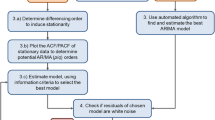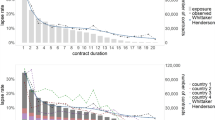Abstract
The aim of the paper is to introduce new claim count distributions constructed from different waiting time assumptions, such as the Exponential, Gamma and Weibull distributions. These models are then fitted to panel data with Gamma distributed random effects. The random effects allow for serial dependence and take residual heterogeneity into account. Predictive distributions are obtained with the help of Markov Chain Monte Carlo simulations. The approach is illustrated on the basis of a Belgian motor third party liability insurance portfolio observed for three years.
Zusammenfassung
Der Artikel stellt neue Schadenzahlverteilungen vor, die aus verschiedenen Annahmen zur Wartezeitverteilung hergeleitet werden. Diese Modelle werden an Paneldaten mit gammaverteilten Zufallseffekten angepasst. Die zufälligen Effekte berücksichtigen serielle Abhängigkeit sowie Heterogenität der Differenzen. Durch Markov Chain Monte Carlo Simulationen werden Prognoseverteilungen gewonnen. Die Vorgehensweise wird anhand eines belgischen Kfz-Haftpflicht Bestandes, der über 3 Jahre beobachtet wird, illustriert.
Similar content being viewed by others
References
Abramowitz M,Stegun IA (1968) Handbook of Mathematical Functions, National Bureau of Standards. Applied Mathematics Series 55. Dover, New York
Bates G, Neyman J (1951) Contributions to the theory of accident proneness. II: True or false contagion, University of California Publications in Statistics 215–253
Boyer M, Dionne G, Vanasse C (1992) Econometric Models of Accident Distribution. In: Dionne G (ed) Contributions to Insurance Economics. Kluwer Academic Press, Boston
Bradlow ET, Fader PS, Adrian MT, McShane B (2006) Count models based on Weibull interarrival times, Working Paper
Burnham KP, Anderson DR (2002) Model Selection and Multi-Model Inference: A Practical Information-Theoretic Approach. Springer, New York
Cameron AC, Trivedi PK (1998) Regression Analysis of Count Data. Cambridge University Press, New York
Feller W (1943) On a general class of ‘contagious’ distributions. Annals of Mathematical Statistics 14:389–400
Golden RM (2003) Discrepancy risk model selection test theory for comparing possibly misspecified or nonnested models. Psychometrika 68:229–249
Keiding N, Andersen C, Fledelius P (1995) The Cox regression model for claims data in non-life insurance. Astin Bulletin 28:95–118
Lawless JF (1987) Regression methods for Poisson process data. Journal of the American Statistical Association 82:808–815
Lemaire J (1995) Bonus-Malus Systems in Automobile Insurance. Kluwer Academics, Boston
Marshall AW, Olkin I (1990) Multivariate distributions generated from mixtures of convolution and product families. In: Block HW, Sampson AR, Savits TH (eds.) Topics in Statistical Dependence, Lecture Notes-Monograph Series, Vol. 16:371–393 Hayward, CA.
Nelson KP, Lipsitz SR, Fitzmaurice GM, Ibrahim J, Parzen M, Strawderman R (2006) Use of the probability integral transformation to fit nonlinear mixed-effects models with nonnormal random effects. Journal of Computational and Graphical Statistics 15:39–57
Pinquet J (2000) Experience rating through heterogeneous models. In: Dionne G (ed.) Handbook of Insurance:459–500 Kluwer Academic, Boston
Rivers D, Vuong Q (2002) Model selection tests for nonlinear dynamic models. Econometrics Journal 5:1–39
Scollnik DPM (2001) Actuarial modeling with MCMC and BUGS. North American Actuarial Journal 5:96–125
Smith AFM, Roberts GO (1993) Bayesian computation via the Gibbs sampler and related Markov Chain Monte Carlo methods (with discussion). Journal of the Royal Statistical Society, Series B 55:3–23
Vuong QH (1989) Likelihood ratio tests for model selection and non-nested hypotheses. Econometrica 57:307–333
Winkelmann R (2003) Econometric of Count Data, 4th edn. Springer-Verlag, Berlin
Winkelmann R (1995): Duration dependence and dispersion in count data models. Journal of Business and Economic Statistics 13:467–474
Winkelmann R, Zimmermann KF (1991) A new approach for modeling economic count data. Economics Letters 37:139–143
Winkelmann R, Zimmermann KF (1995) Recent development in count data modelling: Theory and application. Journal of Economic Surveys 9:1–24
Author information
Authors and Affiliations
Corresponding author
Rights and permissions
About this article
Cite this article
Boucher, JP., Denuit, M. Duration dependence models for claim counts . Blätter DGVFM 28, 29–45 (2007). https://doi.org/10.1007/s11857-007-0003-5
Received:
Accepted:
Published:
Issue Date:
DOI: https://doi.org/10.1007/s11857-007-0003-5




